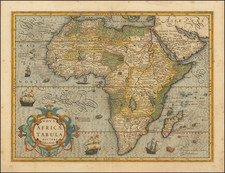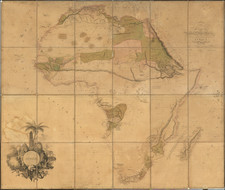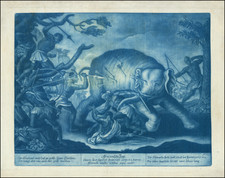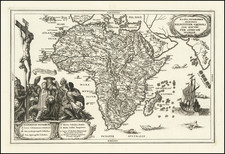A Map Promoting The Recently Formed Free Congo State
Decorative map of Africa, published in France, Belgium, and Italy, identifying the colonial and independent regions of Africa. Guinea, Congo, Cape Colony, Madagascar, Zululand,
The map is embellished with vignettes showing indigenous peoples in Algeria, Morocco, Senegal, Transvaal, Zanzibar, Abyssinia, Sudan, Tunisia and Egypt
The focal point of the map is the recently formed Free Congo State, a short-lived private enterprise created by King Leopold II of Belgium, which would go on to become one of the greatest International exploitation scandals of its time and which would be memorialized in literature by Joseph Conrad and Arthur Conan Doyle.
The flags of various nations indicate the location of Colonial powers. Included in the key are the regions described as:
- Free Congo State
- French Possessions
- Portuguese Possessions
- German Possessions
- Sultanate of Zanzibar
- Spanish Possessions
- English Possessions
- Italian Possession
The first title in French describes the map as locating Belgian stations, whereas the title in Italian identifies the map as locating the latest discoveries. A second title in French at the top.
The large inset map focuses on the Basin of the Congo and the Free State of the Congo, which had been created two years earlier in 1885.
Congo Free State
The Congo Free State was a large state in Central Africa from 1885 to 1908, which was in personal union with the Kingdom of Belgium under Leopold II. Leopold II was able to procure the region by convincing the international community that he was involved in humanitarian and philanthropic work and would not tax trade. Via the Association Internationale Africaine he was able to lay claim to most of the Congo basin. On May 29, 1885, the king named his new colony the Congo Free State.
The Congo Free State operated as a corporate state privately controlled by Leopold II through a Non-governmental organization, the International Association of the Congo. The state included the entire area of the present Democratic Republic of the Congo and existed from 1885 to 1908, when the government of Belgium annexed the region.
Leopold II's Free State extracted ivory, rubber, and minerals in the upper Congo basin for sale on the world market, through a series of international concessionary companies, even though its ostensible purpose in the region was to uplift the local people and develop the area. Under Leopold II's administration, the Congo Free State became one of the greatest international scandals of the early-20th century.
The loss of life and atrocities inspired literature such as Joseph Conrad's novel Heart of Darkness, and raised an international outcry. The lack of accurate records makes it difficult to quantify the number of deaths caused by the ruthless exploitation and the lack of immunity to new diseases introduced by contact with European colonists - like the 1889-90 flu pandemic, which caused millions of deaths on the European continent, including Prince Baudouin of Belgium, who succumbed to the deadly virus in 1891. During the Congo Free State propaganda war, European and US reformers exposed atrocities in the Congo Free State to the public through the Congo Reform Association, founded by Roger Casement and the fervent humanitarian journalist E. D. Morel. Also active in exposing the activities of the Congo Free State was the author Arthur Conan Doyle, whose book The Crime of the Congo was widely read in the early 1900s. By 1908, public pressure and diplomatic maneuvers led to the end of Leopold II's rule and to the annexation of the Congo Free State as a colony of Belgium.
Rarity
The map is apparently very rare. OCLC locates only an 1891 edition of the map in the National Library of Spain.













![[Wall Map of Africa] L'Afrique Divisee en ses Principales Parties et ses Isles Tire des Relations les plus Recentes . . . 1782](https://storage.googleapis.com/raremaps/img/small/91459.jpg)
![[ Africa ] Philips' Graphic Relief Wall Maps](https://storage.googleapis.com/raremaps/img/small/102098.jpg)